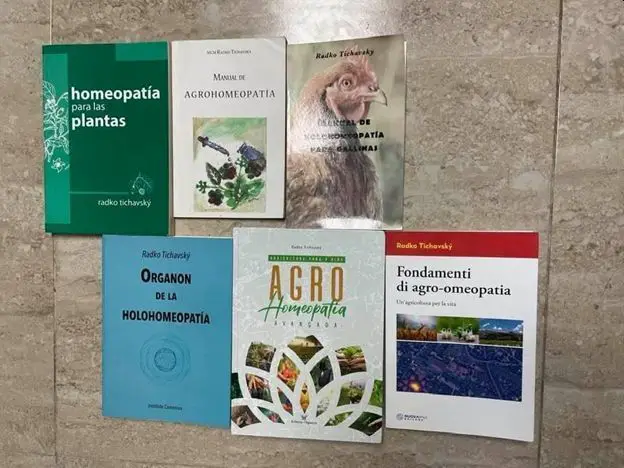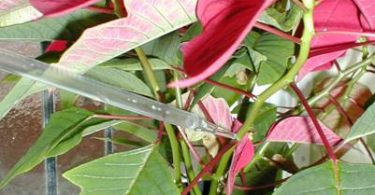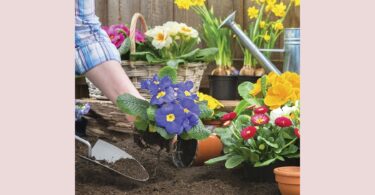NEW: Welcome to the Agrohomeopathy Symposium! – Nov 24th, 2022
Sponsored by The European Committee for Homeopathy (ECH) Speakers: Leoni Villano Bonamin, Francesco di Lorenzo, Giovanni Dinelli, Leonardo Faedo, Ileana Rîndașu, Radko Tichavsky – Register: https://homeopathyeurope.org/agrohomeopathy-symposium-2022/
New Video from Dr. Radko Tichavsky!
In this video, renowned Agrohomeopath Dr. Radko Tichavsky explains Holohomeopathy, the more advanced method of agrohomeopathy: https://youtu.be/GUUoO6Lt-U8 (English subtitles)
Editor’s Note: JT (Jenichen / Tichavsky) potency is often mentioned in these columns. It is a centesimal dilution followed by 500 succussions or five hundred continuous turns with a wooden stick to the right and 500 turns to the left (if handling larger volumes). The JT potency frequently has a better reaction in plants and it is very important in preparation of live bionosodes.
Greetings Dr. Tichavsky,
I am doing organics banana farming through the drenching method. One of my plots is more salty soil. Can I change my soil in to a healthy one through homoeopathy? Are there some alternative fertilizers
I live in In India, the South part of Tamilnadu. Thoothukudi District. The climate – is tropical. Water Source – Canal Water (Thamirabarani River)
(Using fertilizer Urea, Complex, Super, DAP & Pottash )
Thanks & regards
Siva Gnanam
Radko Tichavsky:
Dear Siva,
Musa paradisiaca (banana) is a particularly demanding crop in terms of nitrogen and potassium nutrition. This leads growers to the idea that they must supplement the nutrition of this crop with inputs of synthetic or animal origin, both of which increase the salinity in the soil and increase the content of heavy metals in the soil, and ultimately damage the fertility of soils and crops.
The major (and cheapest) source of nitrogen is found in the air. Nitrogen accounts for 78% of the air. Nitrogen-fixing bacteria include green sulfur bacteria, actinomycetes, cyanobacteria, all the Proteobacteria which can make Nitrogen available to the plants.
Important bacteria for fixing nitrogen from the air are for example: Acetobacter, Azoarcus, Azospirillum, Bacillus (e.g. Bacillus sphaericus), Burkholderia, Herbaspirillum, Klebsiella, Rhizobium, and Pseudomonas.
You will find them in the root system of grasses such as Paspalum spp, Miscanthus sinensis and Pennisetum purpureum and especially important are the arbuscular vascular bacteria and fungi (VAM) that collaborate with native grasses.
You should prepare live bionosode from the roots of the grasses you find in your holon. Blend them in a blender with a liter of non-chlorinated water, and separate the liquid part.
Add to this liquid from the roots two liters of carbonated water (with CO2 bubbles) and put this mixture in 100 liters of water. Add also a 1 kg of cane sugar and let it multiply for 2 days stirring the mixture twice a day with a wooden stick.
From this liquid prepare bionosode vivo 3 JT always using non-chlorinated water, and sprinkle it on the soil around the seedlings.
It is very important to reduce fertilizers to a minimum and/or gradually stop using them, otherwise the bacteria and fungi that you inoculated to fix nitrogen and to collaborate with the nutrition of your bananas will perish.
The mycorhizic bacteria and fungi that I mention not only fix nitrogen, but also produce growth hormones and make available potassium and other nutrients necessary for good growth and harvest of good caliber fruit with excellent flavor.
In this way you will achieve a lower cost of production and above all, you will decrease the salinity caused by the constant use of fertilizers. It will also reduce the accumulation of heavy metals that cause toxicity and decrease the bioavailability of macronutrients for your plants.
Hello Dr. Tichavsky,
We have an English Holly tree that’s been declining over the past year. The drought this year has been rough but it was also infested with termites last year. Any suggestions? I have no idea what remedy to try other than silica. We live in Tempe, Arizona, U.S. (zipcode – 85282).
Summers are s very hot and dry, winters are cool. The temperature typically ranges from 44°F to 106°F.
Thank you
Jeffrey
Radko Tichavsky:
Hi Jeffrey,
Ilex aquifolium (English Holly tree) is frequently visited by termites, especially when dealing with dehydrated trees affected by high ozone levels in the area.
Prepare a mixture of Aloe vera in water in a 1:5 ratio. You can dynamize it in water at 2 JT potency and add about 10 ml of cedar (Cedrus atlantica) essential oil per 50 liters of remedy and spray it on the termite infested tree.
Ilex aquifolium are affected in their growth mainly by high levels of ozone in the air. The presence of ozone in your area is high and is mainly due to vehicle emissions, emissions from industries, power plants and products such as solvents and paints. Ozone levels in the soil can cause or aggravate plant problems especially during the warmer months.
In this sense termites are not the problem per se, but their presence bioindicates and stems from devitalization due to highly reactive forms of oxygen (O3) known as ROS in the Tempe area.
To mitigate the effect of ozone pollution apply Opuntia ficus indica 3 JT foliar sprayed especially in the hot season, keeping the tree well hydrated.
Dear Dr.Tichavsky,
I need a solution to a sandfly/midge infestation. We have brought in soil from another location to our backyard but unfortunately it came with a community of sandflies. I need them to find another home, preferably really far away from me . Should I be working on changing the environment of the soil with homeopathics or should I focus on the sandflies themselves? We live in Vermillion Valley, Ohio, U.S. (zipcode 44089). Summers are warm, winters are freezing, snowy. The temperature varies from 21°F to 81°F .
Thank you
Tracy
Radko Tichavsky:
Hi Tracy,
Sandfly/midge infestation is generally related to soils containing livestock droppings. “Soil tourism” is a frequent way to introduce them into new habitats.
Of the adults, it is only the blood-sucking females, and most people concentrate their attention on them, applying insecticides or repellents, which are generally not very effective and cause increasing resistance to them.
To stop these insects, it is necessary to concentrate on the management of the larvae that are mainly found in damp places in the soil. We use live bionosode of Bauveria bassiana 1 JT, an entomopathogenic fungus that, once established in the soil, parasitizes soft-bodied insects, including sandfly/midge insect larvae.
Bauveria bassiana can be purchased on the internet. Order a small amount that you dissolve in a ratio of 1:100 in non-chlorinated water; make 500 vigorous succussions and apply by means of a sprinkler on the soil. You must make the application early in the morning or after 16 hours to avoid the sun rays that are harmful to the spores of the fungus.
The application can be repeated as needed, but generally after two or three applications the problem will be solved.
Greetings Dr. Tichavsky,
Some of my outside plants have been attacked by clouds of whiteflies. They’ve been terrible on the wild ginger and now on the Chelidonium majus plants. Before I try something else, can a homeopathic remedy help me with this? How to apply?
Abbeville, Louisiana, U.S. -70510.
Jan Feb Mar Apr May Jun
Average high in ºF 59 62 70 77 85 90
Average low in ºF 38 41 49 56 65 71
precipitation in inches 5.44 5.34 5.30 4.55 4.72 5.38
Thank you
Linda
Radko Tichavsky:
Hi Linda,
Whiteflies generally replicate in wet conditions and are associated with a wide range of plants. Whiteflies mainly attack new leaves which have a softer surface that allows the stipe (sap sucking apparatus) to enter.
You can apply Calcarea carbonica 6 CH mixed with Boswellia sacra (common Frankinscence). Crush the incense to a fine powder and put this powder in 30% grain alcohol for one week. Then you prepare a dynamization at potency 3 JT by dissolving the TM (mother tincture) in a ratio of 1:100, making 500 vigorous succussions at each dynamization.
Once the remedy is dynamized, you can add Calcarea carbonica 6 CH and apply every three days by spray on the affected plants, until the problem ceases. It is important to apply the remedy instead under the leaves, where the whitefly eggs and the adults are located.
Dear Prof. Tichavsky,
I have two potted plants of Nandina Domestica (Berberidaceae) which are often attacked by sucking insects (aphids, cochineal, above all): can I prepare a specific homeopathic remedy to mitigate this more violent erosion during the hot seasons? Also, if possible, another homeopathic advice to not let a Cyclamen (Cyclamen persicum / Primulaceae) die again due to the pathogenic fungus Gloeosporium cyclaminis. Thank you so much!
Thank you
Roberto Migliorelli
Radko Tichavsky:
Hi Roberto,
To treat Nandina domestica you can apply Allium sativum 3 JT. It’s better to prepare the remedy yourself from the mother tincture made in olive oil and garlic. The TM is emulsified in water and applied in the season before the hot season (the oil could burn the leaves in combination with ambient heat). You can also apply Boswelia sacra 3 JT sprayed during the hot season, as long as you apply it after sunset.
As for Gloesporium cyclaminis, this is a soil fungus, which acts mainly at flowering time. This fungus is able to survive for about two years in the soil and is spread by spores transmitted in water or through the air. Affected plant parts should be carefully removed and burned (not composted).
Control and reduce humidity in the greenhouse, space plants sufficiently, cut and burn affected leaves and flowers, always use healthy planting material and disinfected seeds, keep plants ventilated and dry using subirrigation, and do not hydrate plants by sprinkling.
As for biological control, the application of Trichoderma sp. does not show consistent antagonism results under field or greenhouse conditions. For fungus control you can use plants containing Lycorine, e.g. Narcissus sp. Bulb. Prepare TM and dynamize to potency 3 JT with Aloe vera leaf slime as an adjuvant.
Sir,
I Am planting Dragon Fruit Plants. Please guide me regarding homeopathy, etc for nutrients, plant growth.
Thank you
Bhalchandra Saner
Radko Tichavsky:
Hi Bhalchandra,
There are several varieties of Dragon fruit: Hylocereus undatus (white fleshed fruit), Hylocereus costaricensis (red fleshed fruit). also known as H. polyrhizus, as well as Hylocereus megalanthus (yellow skin and white flesh).
Because Hylocereus sp. is an epiphytic cactaceae, it exchanges a wide range of bacteria and VAM fungi with the trees on which it is supported. So, the key to successful Dragon Fruit production is in the stakes. Deadwood stakes can be used, but the most beneficial are live stakes.
Some of the trees commonly used are: Gliricidia sepium or Erythrina sp. (especially good because they collaborate with nitrogen fixing bacteria in the soil, and VAM fungi, which produce growth hormones, protect the cactaceae against predators and pathogens and at the same time naturally fertilize Dragon fruit plants. Spondias purpurea and Ficus spp. are also used.
Constant pruning is recommended to avoid too much shade to the crop root attachment. Live stakes are faster compared to dead stakes. Soft bark allows a good adherence of adventitious roots to the crop.
Preparations from the stakes (roots, fruits and especially the bark) are also used as constitutional remedies for ailments and pests in this crop.
SEND your questions to: [email protected] by the 6th of each month.
Holohomeopathy Course: Dr.Tichavsky is now offering a one-semester virtual diploma course in Holohomeopathy (in English). Learn how to analyze holons and how to repertorize the specific homeopathic treatment beyond just disease or pest names. To learn more: www.icomenius.edu.mx Contact: [email protected]
BOOKS ON HOLOHOMEOPATHY
Many readers asked about Radko Tichavsky’s books. Below is a photo of them. They are available in Spanish, Italian and Portuguese. For ordering or information: [email protected]





